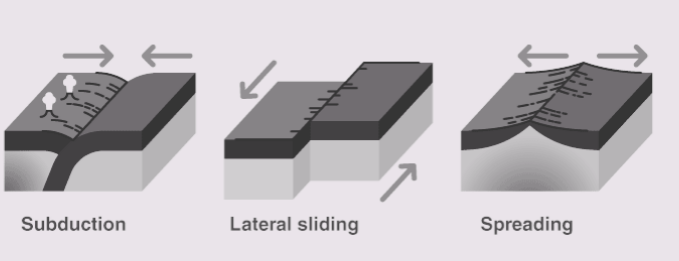Today we are going to discuss very important topic named as plate tectonics. We will discuss all the key details about tectonic plates.
Let’s start.
Table of Contents
Theory Of Plate Tectonics
The widely accepted scientific hypothesis known as plate tectonics postulates that the Earth’s lithosphere is made up of many sizable tectonic plates that have been steadily moving for billions of years.
The model is based on the idea of continental drift, which was created in the early 20th century. After seafloor spreading was confirmed in the mid- to late 1960s, plate tectonics became largely accepted by geoscientists.

Image Credit: Byjus
Description Of Tectonic Plates
Oceanic lithosphere and thicker continental lithosphere make up tectonic plates. The crust covers these two layers. Volcanic activity caused plates to migrate relative to one another. By spreading the seafloor, this process produces new crust at divergent borders.
The lithosphere’s overall geoid surface area doesn’t change during this procedure. The conveyor belt principle is another name for this plate tectonics forecast. Older beliefs that have subsequently been proven false suggested that the world was gradually contracting or growing.
Working Concept
The lithosphere and asthenosphere are the two outermost layers of the Earth. Different mechanical qualities and kinds of heat transmission are used to categorize things. The asthenosphere is hotter and more fluid than the lithosphere, which is colder and harder. The asthenosphere possesses a virtually adiabatic temperature gradient and also transports heat by convection, whereas the lithosphere loses heat through conduction. Tectonic lithospheric plates are fully covered by crust.
Plate boundaries are linked to geological occurrences like earthquakes and the development of topographical features including mountains, volcanoes, mid-ocean ridges, and trenches. The Pacific Plate Ring of Fire is now the most active and well-known plate boundary, where the majority of the world’s active volcanoes are located. Below is a list of these restrictions. There are certain volcanoes that form inside the plate, and these are variously attributed to mantle clouds and plate deformations…
Continental crust can be found on tectonic plates, and most of them have both. For instance, the African Plate contains portions of the floors and continents of the Atlantic and Indian oceans. Oceanic and continental crust differ from one another based on how they were formed. Oceanic crust is created at seafloor spreading centers, and continental crust is created by the tectonic and volcanism processes of arcs, some of which may produce ophiolite sequences as they deposit terrain. the traditional sequence of subduction, diffusion centers, and continent creation. Density of oceanic crust is high due to its mineral compositions.
Effects Of Plate Tectonics
There are several repercussions of plate tectonics, including earthquakes, volcanism, and the formation of mountains. The biosphere and the geosphere and biosphere both experience elemental recycling as a result.
FAQ
What Causes Plate Tectonics To Move?
The plates move occasionally toward and occasionally away from one another due to the heat produced by nuclear processes occurring within the planet’s interior.